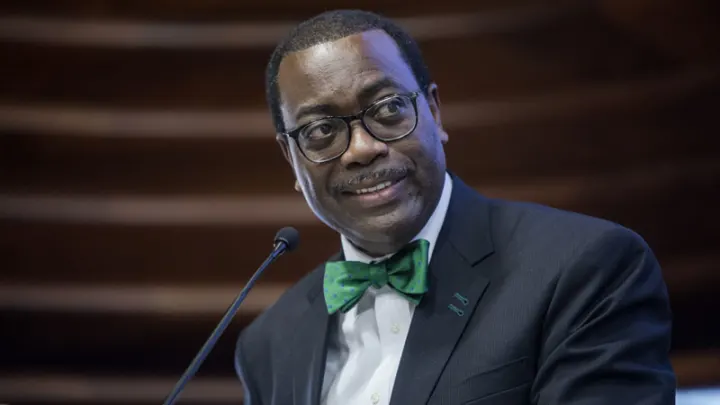By Jeff Kapembwa
The devastation of the climatic change crisis in Africa has undoubtedly left an indelible mark on the environment and economies of the affected countries but the African Development Bank-the continental and Pan African lender has extended a helping hand in the ‘loss and damage’ and ignited a recovery process.
In an estimated 10-year-period-2024-2033, the Pan African lender wants to jointly work with various governments to resolve pressing challenges and to help put the continent firmly back on track towards sustained economic growth and prosperity-more or so, pacifying over climate change.
AfDB group President Akinwumi Adesina, whose institution turns 60 this year unveiled the 10-year- strategy. He remains optimistic a-turn-on the fate of Africa and says, there is still hope for a revival and recovery of much of the losses incurred during the crisis for as long as leaders remain resolute.
“As Africa’s premier development finance institution, and Africa’s solutions bank, we are acutely aware that the next decade will be decisive in transforming the continent. Therefore, as we celebrate 60 years of making a difference in the countries and lives of the people of Africa, we remain resolute in our determination to accelerate the support we provide to African countries.” he told teh delegates
He outlines various headwinds that have decimated the continent’s growth projections noting that the aftermath of the COVID-19 pandemic has resulted in heightened food insecurity and a burgeoning debt crisis across Africa.
At the same time, the impacts of climate change are intensifying and accelerating, alongside a surge in conflict and political instability. Compounded by a youthful demographic outpacing job creation, Africa is witnessing a significant exodus of its future workforce seeking opportunities abroad.
The blueprint, which has since been given ‘thumbs up’ by the Board earlier this year, arguably to make decisive and urgent actions the Bank aims to support African countries navigate the unprecedented global and regional challenges.
The actions planned are expected to be built on Africa’s multiple unique assets and reignite momentum towards achieving the African Union’s Agenda 2063 and the United Nations Sustainable Development Goals (SDGs), ultimately, fostering lasting growth.
Central to the 2024–2033 strategic vision is the firm belief in Africa’s vast potential for societal and economic transformation.
By leveraging the youngest and fastest growing workforce in the world, rapidly growing urban markets, the wealth of natural resources and vast clean energy potential, Africa stands poised to drive sustainable growth and make significant contributions to global solutions over the next decade, a fulfilment of the AfDB’s vision to meet the 5 Highs.
“The Ten-Year Strategy outlines how the Bank will invest in Africa’s best asset: its vibrant young men and women. Africa’s population, which is the fast growing in the world, presents the continent with an unparalleled demographic window of opportunity,” Adesina said.
The new strategy articulates a vision of a prosperous, inclusive, resilient, and integrated Africa, underpinned by two key objectives over the next decade: accelerating inclusive green growth and fostering prosperous and resilient economies. With an emphasis on sustainability, the Bank will strive to balance environmental concerns, equity, and economic advancement.
Building upon the past decade of successful High 5 implementation, the Bank aims to accelerate and scale up its efforts, focusing on transformative projects with far-reaching impacts. To optimise results while managing risks, the Bank will streamline its operational model for increased agility and effectiveness. The Bank’s High 5 operational priorities listed below, are integral to achieving these objectives:
- Light up and power Africa: Promote universal access to modern and affordable energy.
- Feed Africa: Ensure food security through agricultural transformation.
- Industrialise Africa: Catalyse manufacturing as a critical driver of job creation.
- Integrate Africa: Foster regional integration and value chains for a more cohesive economy.
- Improve the quality of life: Enhance living standards, particularly for women and youth.
Key cross-cutting priorities include promoting gender equality, investing in young people, responding to climate change, and investing in climate action, supporting fragile states, and promoting good governance and economic stability.
The Bank sees the pivotal role of the private sector in driving Africa’s transformation. Over the next decade, it will strengthen collaboration with the private sector, prioritising investments in firms, value chains, and micro, small, and medium-sized enterprises especially those led by women and youth.
The magnitude and urgency of the challenge will require greater resources than before. The Bank pledges to mobilise resources from diverse sources, including domestic revenues and private finance.
It aims to triple private-sector finance by 2033 while bolstering its financing capacity through innovative mechanisms. In response to calls for Multilateral Development Banks (MDBs) to maximise the potential of their balance sheets, the Bank will pursue various options to boost its financing capacity over the life of the Ten-Year Strategy.

